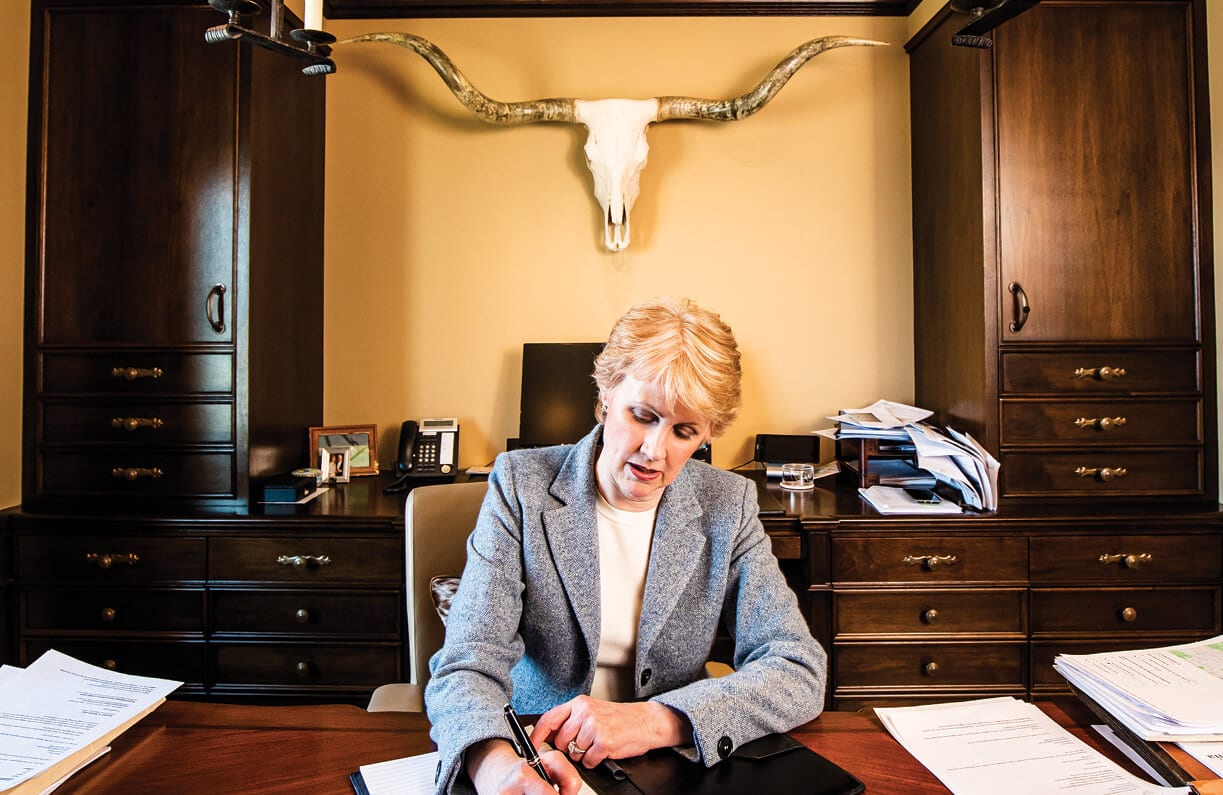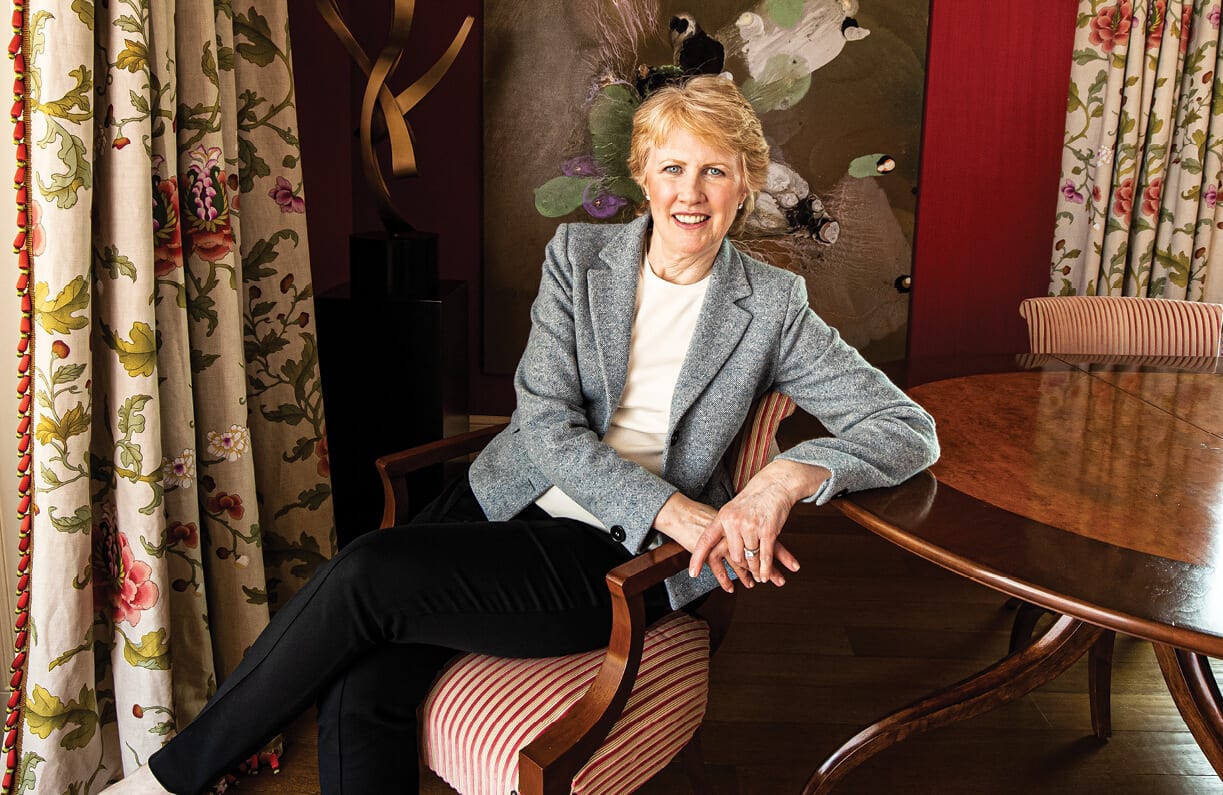Constance Moore, MBA 80, is a master at turning properties into big revenue
In the spring of 1977, Constance “Connie” Moore walked into an office on the 42nd floor of the Bank of America Building in San Francisco seeking a job. She was wearing a white polyester pantsuit, a blue shirt, and a necktie. “I’d never worn a men’s tie before and haven’t since,” she says with a laugh. “I don’t know what compelled me to do that.”
One semester shy of finishing her undergraduate business degree at San Jose State University, she was competing against Stanford and Harvard MBAs for a job as an analyst at Bank of America Realty, which had never before hired a woman for the position.
Nevertheless, something about Moore’s swagger impressed the company. “I probably got a little cocky telling them all the things I could do,” she says. When offered a job as a summer intern, she countered, asking for a 6-month internship instead. The company agreed, offering her $1,000 a month, a small fortune for her at the time.
“For my first assignment, they flew me first class to Memphis to do a budget for a troubled asset that was projected to lose $6 million,” she says. The temporary job turned into a permanent position after graduation, and soon she was turning around problem properties from Hawaii to New York. “I became the work out lady. It was like, you’ve got a problem, how do I fix it?” she says. “It was more responsibility than any 22-year-old should have had, and I loved it.”
That love turned into a 37-year career working in real estate investment trusts (REITs), companies that invest in income-generating properties to earn a profit. In 2002, decades after leaving Bank of America, she came back to the company, now known as BRE Properties. As CEO, she navigated it through the turbulent 2008 financial crisis and left it stronger than before, the crowning achievement in a remarkable real estate career. In November, Berkeley Haas honored Moore with a Lifetime Achievement Award—only the eighth person to receive the accolade.
Professor Nancy Wallace, co-chair of the Fisher Center for Real Estate & Urban Economics for which Moore chairs the Policy Advisory Board, says Moore is a pioneer. “She was one of the first women in the industry, and she did it seemingly with ease and grace. She is hugely respected for both her business acumen and her leadership.”
Turning passion into confidence
Growing up in San Jose, Moore was exposed to the real estate industry early, watching her father work building houses and selling insurance. She never expected to go into the business herself, however. “I was supposed to go to college for two years and get some culture then get married and have children,” she says. Something clicked, however, as she started taking classes in real estate law and finance. She started dreaming of a career in the industry.
Initially, Moore’s colleagues were men in their 30s with graduate degrees. So to compete, Moore enrolled in Berkeley’s evening MBA program, then in San Francisco. She took classes on Monday and Thursday nights, traveling in between for work and studying all weekend.
“I could see her potential from day one, year one,” says Ken Rosen, professor emeritus and Fisher Center co-chair, who was then just starting out. He remembers Moore knowing more about some aspects of the industry than he did. “She had the intellectual ability to digest complex topics and express them in a way that was understandable to the layperson.”
For Moore, earning an MBA allowed her to trust the confidence she only pretended to have before. “It made me fearless and gave me much more credibility and competence than that silly white pantsuit,” she says. She left Bank of America in 1983 to work for a firm called Consolidated Capital, thrown into the deep end of managing properties and public limited partnerships.
In those early days, men often underestimated her talents. She learned not to take it personally, developing an alter ego she called Sally Sunshine. “If I ever got into an uncomfortable situation, Sally would kick in, and she would make light of it. It was my coping mechanism,” Moore says. She succeeded by working twice as hard as the men around her, never saying no to an opportunity that allowed her to learn more about the business. “I went to work for a reason, and that was to work. I didn’t want to get caught up in all that other stuff.”
A trusted leader

Eventually she landed a position with Security Capital, a Santa Fe, N.M.-based real estate holding company run by visionary investor Bill Sanders, working her way up to managing director. Under Sanders’ tutelage, Moore took the company’s East Coast apartment holdings public in 1996 as Security Capital Atlantic and then oversaw the merger with another Security Capital-sponsored REIT. The merged companies were rebranded Archstone Communities, which became one of the leading REITs of the 2000s.
She would have stayed at the company longer had Sanders not decided to sell it in 2002. That’s when Moore got a call from a headhunter, to interview for a position in San Francisco. Only when she became a finalist did she realize that it was for BRE Properties, which had now grown to nearly 1,000 employees and managed tens of thousands of multifamily housing units.
She joined BRE as president and chief operating officer in the fall of 2002 and in 2005 assumed the top spot as CEO, learning to develop talent as well as she had properties. “Her leadership qualities really set her apart,” says John Schissel, who was her executive vice president and CFO. “She taught me about the importance of culture, so everyone wants to be part of a company’s success.”

Moore implemented a “feedback organization,” in which any employee could approach any other employee with comments on their performance, as long as they did it directly and respectfully. “It was all about building trust,” Moore says. “The more we practiced it, the more we could see it was making a difference.”
Schissel says Moore set a tone of problem-solving rather than finger-pointing. “Whenever there was a tough moment, she was never one to second-guess anybody,” he says. “There was a time for accountability and learning from mistakes, but in the heat of the moment, she was very forward focused on whatever was needed to solve the problem.”
Navigating a crisis
No sooner had Moore assumed the leadership of BRE than she changed the company ’s strategy. Instead of buying and managing properties throughout the West, she focused narrowly on the West Coast, developing locations from Seattle to San Diego. That meant sometimes selling, in real estate terms, higher cap rate properties and buying lower cap rate properties with more earnings potential over time. “That strategy was not without some tough decisions and messaging with investors focused on current earnings, but ultimately it was the best thing for the company,” Schissel says.
Moore faced her biggest challenge, though, when the financial crisis hit in September 2008, and rents on some properties went down by 30% or more. “Our stock went from $72.50 to $17.04—and I remember those numbers exactly,” Moore says. The company still had access to capital through Fannie Mae and Freddie Mac, however, and Moore stayed the course, resisting the temptation to sell assets or draw down on a line of credit. “It was ugly, but we didn’t have so much leverage that we were going to go out of business,” she says. “We just had to work through it and not panic.” By early 2010, the company was buying assets again, taking advantage of depressed prices to get even more promising properties in its development pipeline.
Whenever Moore needed refuge, she and her husband, Roger Greer, flew out to their 400-acre ranch in Texas. “I never really took a vacation, because when you’re a leader, nobody does your work when you’re away, but I could sit out in the middle of the pasture in a golf cart with my laptop and the cows around me,” she says. “It was a great way to clear my head.”
Ultimately, her strategy with the company succeeded, growing BRE’s portfolio to an enterprise value of over $6 billion, nearly double the amount when she started as CEO.
In fact, she may have succeeded too well. In 2013, Essex Properties, one of the giants in the REIT industry, approached BRE to talk merger. The deal made sense—while Essex dominated the San Francisco Bay area, Moore’s strong development pipeline could extend its reach along the West Coast. Moore knew that the merger would mean layoffs, starting with herself, but she didn’t hesitate to support the decision.
“She recognized it was absolutely in the best interest of our shareholders,” says Irving “Bud” Lyons, who was chairman of BRE’s board, “and as it turns out, it was the right decision.”
True to form, Moore’s first priority was to take care of her people, holding weekly meetings during the next five months to speak with every employee. “By the time the merger happened, they all knew where they were going to be, what was going to be happening, and who was leaving,” she says.
Of course, the dissolution of the company was bittersweet for Moore, closing the chapter on her career at BRE. “I call it my bookends—my first job and my last job,” she says. “But it was a really good process in the end.” The deal closed on April 1, 2014, creating a real estate behemoth with more than 50,000 housing units in some 250 properties—and leading to Moore’s retirement after almost four decades in the real estate investment business.
A working retirement
She’s hardly slowed down in the last five years, however. By the time the deal closed, Moore had already assumed positions on the boards of two public companies, Civeo Corporation and Tri Pointe Group, and soon joined the boards of BRIDGE Housing—a nonprofit developer of affordable housing, Columbia Property Trust, and the Urban Land Institute’s Global Board.
She had also long been active with both of her alma maters, serving on the board and executive committee for San Jose State’s Tower Foundation and on the Haas School Board. She continues as chair of the Policy Advisory Board for Haas’ Fisher Center, a position she’s held since 2005, where she’s helped arrange speakers and serves as the master of ceremonies for a biannual convening of real estate professionals from around the country for off-the-record conversations.
“They are designed to be truth-telling meetings,” says Prof. Wallace. “People come away feeling like they can anticipate what’s going to be on the front page of The Wall Street Journal in a month.” Moore has been integral to setting that tone, Wallace says, making professionals feel at home with a mix of straight talk and passion.
Moore also speaks to Berkeley MBA students about her career. “She tells them that people trust you when you do a deal and you do what you say you will do,” Wallace says. “With the volatility in these industries, that message is extremely important.”
Receiving the Lifetime Achievement Award from Haas is a homecoming, bringing Moore back full circle from those night classes in San Francisco all those years ago.
“It’s very humbling,” she says. “Haas provided the foundation as well as the tools for me to achieve a level of success beyond my wildest imagination, and for that I will be forever grateful. I hope I have exemplified our Defining Leadership Principles and that my commitment to service will inspire others to do the same.”
